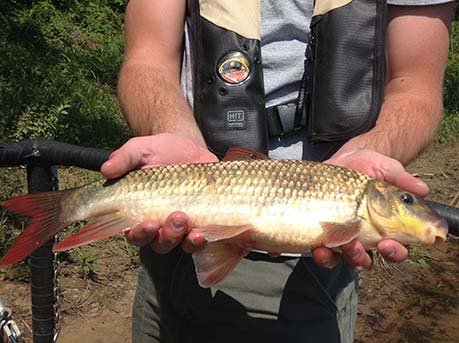Species Restoration
DNR's Robust Redhorse Re-introduction Reaches Important Milestone
The twelve year effort to reestablish robust redhorse to the Santee River System is showing signs of success. This project has been part of a three-state effort to restore robust redhorse population to the Atlantic slope rivers of Georgia and the Carolinas..

The robust redhorse is a large, long-lived member of the redhorse sucker family. It is an important part of our native aquatic ecosystem, serving as a host for the parasitic stages of native mussels and helping to control invasive corbicula clams. Adults can live up to 27 years, reach 30 inches in length, and weigh up to 18 pounds. The species was rediscovered in Georgia in 1991 after being lost to science for over 100 years. Three remnant populations were subsequently identified and a cooperative effort, begun in 1995 between state, federal, and private entities, has been underway to recover the species to avoid its listing as a federal threatened and endangered species.
Over nine years, 72,000 5-inch juvenile robust redhorse were produced and stocked by DNR hatcheries into the Santee River System using parents collected from the Savannah River. Observation of mature adults began in 2008 when the initially stocked fish reached four years of age. Since then, mature adults have been seen in every stocked segment of the lower Broad River and the Congaree/Wateree River segment. Nearly 150 adults have been observed using the Columbia fishway to move upstream since 2009. Spawning activity was first observed in 2010, when the first stocked females reached maturity.
Detection of wild spawned robust redhorse would be the next logical measure of project success. Recently, the DNR’s Marine Division Genomics researchers develop a tool to differentiate stocked fish from their wild spawn progeny. Armed with this tool and the collection of several juvenile fish in 2015, verification of two wild spawn juveniles was made this summer. In addition, because of their size, it would appear that these two fish were spawned in two separate years. While not ready to declare complete success, project leaders see this as a major step forward.
This is welcome news to the more than 50 sets of hands that have touched this project and faithfully worked towards this goal. This project was largely funded by the Fish and Wildlife’s State Wildlife Grant program, with the collaboration of and staff support from Duke Energy, SCE&G, Santee Cooper, South Carolina Aquarium, Clemson University, and Kleinschmidt Associates.
